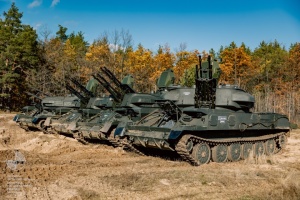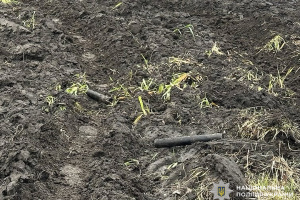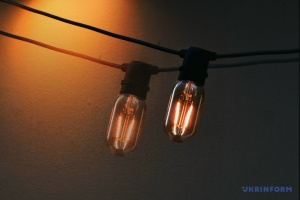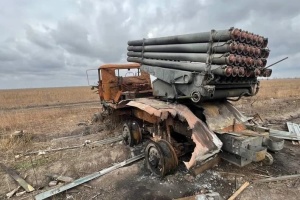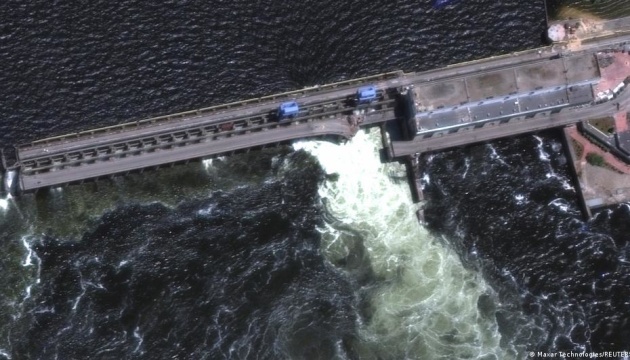
The Kakhovka Hydraulic Power Plant was blown up from the inside. What consequences were predicted half a year ago
On the night of June 6, the Russian occupation forces blew up the Kakhovka HPP. According to Ukrhydroenergo, the Kakhovka HPP has been completely destroyed due to the turbine room having been blown up from the inside, the plant cannot be repaired. As of 9:00 a.m. on June 6, the water level of the Kakhovka Reservoir is rapidly decreasing, the evacuation of the population from areas at risk of flooding has begun.
On February 24, 2022, the Kakhovka HPP and the main structure of the North Crimean Canal, the locks of which regulated the supply of Dnieper water to Crimea until 2014, were captured by Russian troops who invaded Kherson Oblast from occupied Crimea. As early as April 2022, the Russian occupiers mined the dam and equipment of the Kakhovka HPP. At the end of October, the Russians began to threaten to blow up the Kakhovka HPP. Ukrinform has collected data on the potential consequences of the HPP explosion which were predicted at that time (between October 20 and October 30).
Where is the Kakhovka HPP?
The Kakhovka Neporozhnii HPP is located 5 km from the city of Nova Kakhovka, Kherson Oblast. The Kakhovka HPP is a standalone unit of Ukrhydroenergo PJSC, the largest hydro-generating company in Ukraine. 100% of the company's shares are held by the government. Strategic road and railway bridge crossings pass through the hydraulic facility.
The Kakhovka HPP ensures all-year regulation of the Dnipro River flow for power supply, irrigation and water supply of arid areas of southern Ukraine as well as navigation from Kherson to Zaporizhzhia. The construction of the Kakhovka hydraulic facility raised the water level in the Dnipro River by up to 16 metres and created the Kakhovka Reservoir with a volume of 18.19 km³.
For reference: There has already been a similar tragedy in the history of Ukraine. On August 18, 1941, the retreating Red Army blew up the Dnipro HPP. They did it to stop the German advance.
As a result of the explosion, a hole of more than 150 metres appeared in the dam, and a 30-metre-high wave washed away everything in its path. According to various estimates, several dozen villages in the Khortytsia floodplain were flooded at that time, and tens of thousands of people died.
***
COMMENTS
On October 20, 2022, President of Ukraine Volodymyr Zelenskyi warned of catastrophic consequences if the occupiers dare to blow up the Kakhovka HPP.
“Blowing up the dam would mean a large-scale disaster. With such a terrorist attack, they can destroy, among other things, even the very possibility to ever supply water from the Dnipro River to Crimea. Should the Kakhovka HPP burst, he North Crimean Canal would simply disappear.”
In an interview with the British TV channel Sky News, the Secretary of the National Security and Defence Council Oleksii Danilov said:
“We will have to wait and see, but if they do blow up (the Kakhovka HPP - ed.), then Crimea will have no proper water supply for 10 to 15 years, if not forever. It brings us to the question, what do they need Crimea for, if they are going to leave it without water.”
Danilov recalled that the Russian army mined the Kakhovka Dam “with a large amount of explosives.”
In an interview with the Ukrainian Pravda website, the head of the Main Directorate of Intelligence of the Ministry of Defence of Ukraine Kyrylo Budanov said:
“I’ll put it this way: blowing up that dam (the Kakhovka Dam - ed.) would definitely cause an environmental disaster, that’s a fact... The Russian invaders would lose more than they would gain from blowing up the dam in Kherson Oblast. After all, if you completely destroy the dam by launching at it many missiles or planting a lot of explosives, the left bank of Kherson Oblast will be completely flooded. They would lose the very possibility of supplying water to the North Crimean Canal and onwards to Crimea until we rebuild the dam, and that would take a very long time. It would be unfeasible. And the most interesting thing is that they would put the Zaporizhzhia Nuclear Power Plant out of service forever, because this facility is inextricably linked with it. Having said that, they would, of course, make it difficult for us to advance for a certain period of time. And this period, by the way, is not that long, it would be somewhere around two weeks.”
He clarified that the explosion would force the Russian troops to retreat directly to Crimea.
According to the statement of Oleksandr Baranichenko, head of the City Emergency Management Department (Nova Kakhovka), which he made as early as the spring of 2022, even with the destruction of the Kakhovka HPP dam, the water level will rise by 12 metres at most from the current river bank. That is, it won’t even reach Dniprovskyi Avenue of Nova Kakhovka.
Hydrogeologist and chair of the board of the National Ecological Centre Ruslan Havryliuk told the TSN news show that a dam explosion could turn out to be a really terrible disaster — perhaps not as terrible as it is often described, but a terrible one in any case. There is a 400-metre-long dam closing the Kakhovka Reservoir, and there are 150-metre-long hydraulic equipment units of the Kakhovka HPP. If all of this is blown up, a gap of 550 metres can appear – and the water, which stands 16 metres higher in the Kakhovka Reservoir than in the Dnipro River, can come crashing down into the lower reaches of the Dnipro River. First of all, the coastal areas at the left bank of the Dnipro River will be affected. As for the flooding of Kherson and other communities, Ruslan Havryliuk emphasises that the situation may be actually not as critical as it seems. The principal critically affected ecosystem is that of the lower Dnipro River valley, in particular the Lower Dnipro National Park. Water level can rise by 5 metres in Kherson, but within 20 to 40 hours the high water will flow down into the Black Sea.
Director of the Institute of Water Problems and Land Reclamation of the National Academy of Sciences of Ukraine Mykhailo Yatsiuk, sees the probability of the destruction of the Kakhovka HPP as high. “It is extremely difficult to destroy the dam itself, but I assume that explosives can be planted in the emergency spillways or the dock area where the hydraulic equipment units are located.”
The Kakhovka Reservoir is extremely important for the economy southern Ukraine, where it performs a number of tasks. According to Mykhailo Yatsiuk, the crisis affects the primary purpose of the reservoir – irrigation of southern Ukraine. “Should irrigation systems go out of service, the agricultural sector will suffer. It will be possible to fill the reservoir again only in the spring, when there will be an influx of water,” the specialist explains.
Another question is drinking water supply. All settlements located on the banks of the reservoir depend on it staying at this level. If the level drops even by a metre, drinking water intakes will not work and the population will not receive drinking water. The North Crimean Canal also depends on the water level in the Kakhovka Reservoir. If water does not flow there, neither the south of Kherson Oblast nor Russian-annexed Crimea will receive water.
A separate issue, according to Mykhailo Yatsiuk, is the fate of the Zaporizhzhia Nuclear Power Plant. It is cooled by water from the Kakhovka Reservoir. If the water level drops and there is a water shortage in the cooling ponds, this raises the question of the safety of the nuclear power plant and creates a risk of a nuclear accident.
The Minister of Environmental Protection and Natural Resources of Ukraine Ruslan Strelets said at the Yedyni Novyny telethon that the dam explosion would mean a very large-scale environmental disaster. Its consequences would definitely be felt by the whole world and all of Europe. What specific damage would be caused to the environment is difficult to predict, everything would depend on the scale of destruction, what exactly would be destroyed, which parts of the hydraulic structure, etc.
“Firstly, the dam explosion would definitely cause flooding in the city of Kherson, Hola Prystan and Nova Kakhovka, which are located in the Dnipro River valley. How destructive the flood wave will be would depend on the specific conditions of this possible, potential emergency situation. Secondly, we must remember the possible contamination of water with garbage and various chemicals, and this water would then flow down to the Dnipro-Buh Estuary, and onwards to the Black Sea. From the Black Sea, pollutant-filled water can definitely enter the Mediterranean Sea, and we can only make some simulations and forecasts about the likely consequences,” said the head of the Ministry of Environment.
“The most important thing is that should the Russians really take such actions, they can leave the entire Crimean peninsula without Dnipro River water, because the decrease in the water level of the reservoir would simply make it impossible to supply water through the North Crimean Canal to the peninsula,” the minister summarised.
The Main Directorate of Intelligence said that if the dam is blown up, “the scale of the ecological disaster would go far beyond the borders of Ukraine and affect the entire Black Sea region.”
Prepared by Mariana Rabcheniuk, Kyiv

